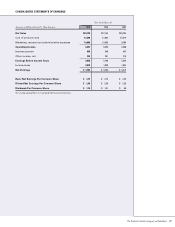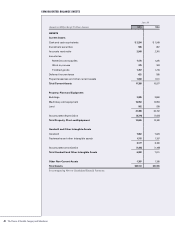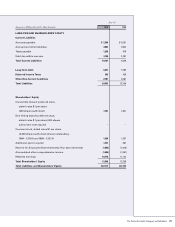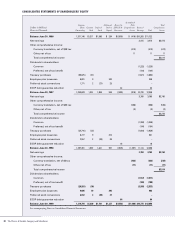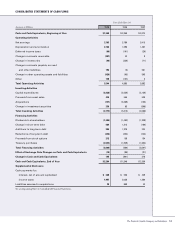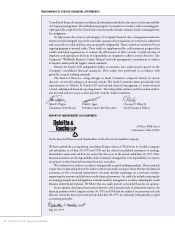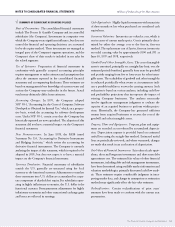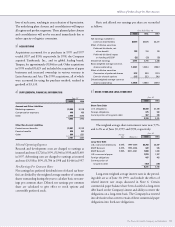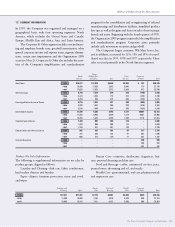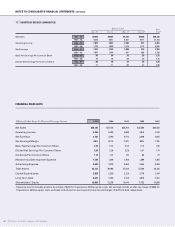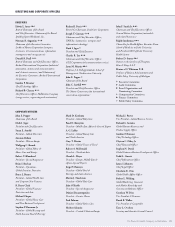Proctor and Gamble 1999 Annual Report Download - page 39
Download and view the complete annual report
Please find page 39 of the 1999 Proctor and Gamble annual report below. You can navigate through the pages in the report by either clicking on the pages listed below, or by using the keyword search tool below to find specific information within the annual report.
Millions of Dollars Except Per Share Amounts
The Procter & Gamble Company and Subsidiaries
35
lives of such assets, resulting in an acceleration of depreciation.
The underlying plant closures and consolidations will impact
all regions and product segments. These planned plant closures
and consolidations will not be executed immediately due to
either capacity or logistics constraints.
3ACQUISITIONS
Acquisitions accounted for as purchases in 1999 and 1997
totaled $137 and $150, respectively. In 1998, the Company
acquired Tambrands, Inc., and its global leading brand,
Tampax, for approximately $1,844 in cash. Other acquisitions
in 1998 totaled $1,425 and included the acquisition of paper
businesses and increased ownership in various ventures in
Latin America and Asia. The 1998 acquisitions, all of which
were accounted for using the purchase method, resulted in
goodwill of $3,335.
4SUPPLEMENTAL FINANCIAL INFORMATION
June 30
1999 1998
Accrued and Other Liabilities
Marketing expenses $1,094 $1,109
Compensation expenses 449 485
Other 2,540 2,348
4,083 3,942
Other Non-Current Liabilities
Postretirement benefits $1,081 $1,193
Pension benefits 926 843
Other 694 1,251
2,701 3,287
Selected Operating Expenses
Research and development costs are charged to earnings as
incurred and were $1,726 in 1999, $1,546 in 1998 and $1,469
in 1997. Advertising costs are charged to earnings as incurred
and were $3,538 in 1999, $3,704 in 1998 and $3,466 in 1997.
Net Earnings Per Common Share
Net earnings less preferred dividends (net of related tax bene-
fits) are divided by the weighted average number of common
shares outstanding during the year to calculate basic net earn-
ings per common share. Diluted net earnings per common
share are calculated to give effect to stock options and
convertible preferred stock.
Basic and diluted net earnings per share are reconciled
as follows:
Years Ended June 30
1999 1998 1997
Net earnings available to
common shareholders $3,654 $3,676 $3,311
Effect of dilutive securities
Preferred dividends, net
of tax benefit 109 104 104
Preferred dividend impact
on funding of ESOP (22) (25) (32)
Diluted net earnings 3,741 3,755 3,383
Basic weighted average common
shares outstanding 1,328.1 1,343.4 1,360.3
Effect of dilutive securities
Conversion of preferred shares 97.2 99.8 101.9
Exercise of stock options 21.5 22.3 24.8
Diluted weighted average common
shares outstanding 1,446.8 1,465.5 1,487.0
5SHORT-TERM AND LONG-TERM DEBT
June 30
1999 1998
Short-Term Debt
U. S. obligations $2,308 $1,435
Foreign obligations 375 560
Current portion of long-term debt 467 286
3,150 2,281
The weighted average short-term interest rates were 5.7%
and 6.2% as of June 30, 1999 and 1998, respectively.
Average June 30
Rate Maturities 1999 1998
Long-Term Debt
U.S. notes and debentures 6.59% 1999 – 2049 $3,760 $2,897
ESOP Series A 8.33% 1999 – 2004 472 545
ESOP Series B 9.36% 2007 – 2021 1,000 1,000
U.S. commercial paper 1,019 1,207
Foreign obligations 447 402
Current portion of
long-term debt (467) (286)
6,231 5,765
Long-term weighted average interest rates in the preced-
ing table are as of June 30, 1999, and include the effects of
related interest rate swaps discussed in Note 6. Certain
commercial paper balances have been classified as long-term
debt based on the Company’s intent and ability to renew the
obligations on a long-term basis. The Company has entered
into derivatives that convert certain of these commercial paper
obligations into fixed-rate obligations.




